


中华护理杂志 ›› 2023, Vol. 58 ›› Issue (22): 2768-2776.DOI: 10.3761/j.issn.0254-1769.2023.22.012
收稿日期:2023-06-05
出版日期:2023-11-20
发布日期:2023-11-17
通讯作者:
罗彩凤,E-mail:lcf0105@163.com作者简介:尚彬:男,本科(硕士在读),E-mail:Sevenage007@163.com
基金资助:
SHANG Bin( ), LUO Caifeng(
), LUO Caifeng( ), LÜ Fei, WU Jing, SHAO Xiao, LI Qian
), LÜ Fei, WU Jing, SHAO Xiao, LI Qian
Received:2023-06-05
Online:2023-11-20
Published:2023-11-17
摘要:
目的 探索社区慢性病共病老年患者心理困扰的潜在类别,分析不同特征的老年患者述情障碍的差异。方法 2022年11月—2023年3月,采用便利抽样法选取江苏省6个地级市中城市和农村685例慢性病共病老年患者为调查对象,采用一般资料调查表、抑郁-焦虑-压力量表和多伦多述情障碍量表进行调查。结果 最终共调查662例慢性病共病老年患者,心理困扰总分为30.00(16.00,52.00)分。心理困扰表现为4种不同潜在类别,分别命名为压力-抑郁型(19.9%)、低困扰型(26.0%)、压力-焦虑型(23.4%)和整体高困扰型(30.7%)。不同心理困扰类别的社区慢性病共病老年患者在年龄、婚姻状况、居住状态、疾病经济压力、1年内急性事件和自觉健康状况方面的比较,差异具有统计学意义(P<0.05)。4个潜在类别述情障碍得分的比较,差异有统计学意义(F=136.544,P<0.001)。结论 慢性病共病老年患者心理困扰具有明显的分类特征,不同心理困扰类别的老年患者述情障碍存在差异。医护人员应重点关注压力-抑郁型和整体高困扰型老年患者的述情障碍,根据不同类别慢性病共病老年患者采取针对性的干预措施以减轻其心理困扰。
尚彬, 罗彩凤, 吕妃, 吴静, 邵校, 李倩. 社区慢性病共病老年患者心理困扰的潜在类别分析[J]. 中华护理杂志, 2023, 58(22): 2768-2776.
SHANG Bin, LUO Caifeng, LÜ Fei, WU Jing, SHAO Xiao, LI Qian. Latent class analysis of psychological distress among older adults with multiple chronic conditions in communities[J]. Chinese Journal of Nursing, 2023, 58(22): 2768-2776.
 |
表1 慢性病共病老年患者心理困扰潜在类别分析各模型拟合指标
Table 1 ndicators of the fit of each model for the analysis of latent class of psychological distress in older adults with multiple chronic diseases
 |

图1 慢性病共病老年患者心理困扰4个潜在类别的条件概率分布情况 注:A为焦虑条目;D为抑郁条目;S为压力条目。
Figure 1 Conditional probability distribution of 4 latent classes of psychological distress in older adults with multiple chronic conditions
 |
表2 不同人口学特征慢性病共病老年患者心理困扰类别比较[n=662,例(百分比,%)]
Table 2 Comparison of classes of psychological distress among older adults with multiple chronic conditions by demographic characteristics[n=662,case(percentage,%)]
 |
 |
表3 慢性病共病老年患者心理困扰类别的多分类Logistic回归(n=662)
Table 3 Multicategory logistic regression of factors influencing psychological distress categories in older adults with multiple chronic conditions(n=662)
 |
 |
表4 不同心理困扰类别慢性病共病老年患者述情障碍得分比较(分,$\bar{x} \pm s$)
Table 4 Comparison of scores for alexithymia in older adults with multiple chronic conditions across psychological distress categories(score,$\bar{x} \pm s$)
 |
| [1] |
Huang K, Yang T, Xu J, et al. Prevalence,risk factors,and mana-gement of asthma in China:a national cross-sectional study[J]. Lancet, 2019, 394(10196):407-418.
DOI PMID |
| [2] |
黎艳娜, 王艺桥. 我国老年人慢性病共病现状及模式研究[J]. 中国全科医学, 2021, 24(31):3955-3962,3978.
DOI |
| Li YN, Wang YQ. Prevalence and patterns of multimorbidity among Chinese elderly people[J]. Chin Gen Pract, 2021, 24(31):3955-3962,3978. | |
| [3] | Ostovar S, Chahardehi AM, Hashim IHM, et al. Prevalence of psy-chological distress among cancer patients in Southeast Asian countries:a systematic review[J]. Eur J Cancer Care, 2022, 31(6):1-13. |
| [4] |
孙柳, 王莹, 梁嘉贵, 等. 老年人应对慢性病共病体验的Meta整合[J]. 中华护理杂志, 2022, 57(6):748-755.
DOI |
| Sun L, Wang Y, Liang JG, et al. Experience of the elderly coping with multiple chronic conditions:a qualitative meta-synthesis[J]. Chin J Nurs, 2022, 57(6):748-755. | |
| [5] | 杨娟, 吕晓珍, 尚丽, 等. 深圳市老年人抑郁与焦虑情绪检出率及相关因素[J]. 中国心理卫生杂志, 2023, 37(5):373-379. |
| Yang J, Lü XZ, Shang L, et al. Detection rates and related factors of depression and anxiety in the elderly in Shenzhen[J]. Chin Ment Health J, 2023, 37(5):373-379. | |
| [6] | 尚超娜, 王剑英, 张冬红. 精神科护士心理困扰现状及其影响因素的研究[J]. 军事护理, 2022, 39(9):17-20. |
| Shang CN, Wang JY, Zhang DH. The status of psychological distress of psychiatric nurses and its influencing factors[J]. Mil Nurs, 2022, 39(9):17-20. | |
| [7] | Shang B, Chen R, Luo C, et al. The relationship between alex-ithymia,depression,anxiety,and stress in elderly with multiple chronic conditions in China:a network analysis[J]. Front Psychiatry, 2023, 14:1-13. |
| [8] |
Ghiggia A, Bottiroli S, Lingiardi V, et al. Alexithymia and psy-chological distress in fibromyalgia and chronic migraine:a cross-sectional study[J]. J Psychosom Res, 2022, 163:111048.
DOI URL |
| [9] |
Taylor GJ. Alexithymia:concept,measurement,and implications for treatment[J]. Am J Psychiatry, 1984, 141(6):725-732.
DOI URL |
| [10] |
Charlson M, Szatrowski TP, Peterson J, et al. Validation of a Combined Comorbidity Index[J]. J Clin Epidemiol, 1994, 47(11):1245-1251.
DOI PMID |
| [11] | 李峥, 刘宇. 护理学研究方法[M]. 2版. 北京: 人民卫生出版社, 2018. |
| Li Z, Liu Y. Nursing research methods[M]. 2nd ed. Beijing: People’s Medical Publishing House,2018. | |
| [12] | Nylund-Gibson K, Choi AY. Ten frequently asked questions about latent class analysis[J]. Transl Iss Psych Sci, 2018, 4(4):440-461. |
| [13] |
Lovibond PF, Lovibond SH. The structure of negative emotional states:comparison of the Depression Anxiety Stress Scales (DASS)with the beck depression and anxiety inventories[J]. Behav Res Ther, 1995, 33(3):335-343.
DOI PMID |
| [14] | 龚栩, 谢熹瑶, 徐蕊, 等. 抑郁-焦虑-压力量表简体中文版(DASS-21)在中国大学生中的测试报告[J]. 中国临床心理学杂志, 2010, 18(4):443-446. |
| Gong X, Xie XY, Xu R, et al. Psychometric properties of the Chinese versions of DASS-21 in Chinese college students[J]. Chin J Clin Psychol, 2010, 18(4):443-446. | |
| [15] | 蚁金瑶, 姚树桥, 朱熊兆. TAS-20中文版的信度、效度分析[J]. 中国心理卫生杂志, 2003(11):763-767. |
| Yi JY, Yao SQ, Zhu XZ. The Chinese version of the TAS-20:reliability and validity[J]. Chin Ment Health J, 2003(11):763-767. | |
| [16] | 王孟成, 毕向阳. 潜变量建模与Mplus应用:进阶篇[M]. 重庆: 重庆大学出版社, 2018:13-15. |
| Wang MC, Bi XY. Latent variable modeling and Mplus application advanced chapter[M]. Chongqing: Chongqing University Press, 2018:13-15. | |
| [17] | 肖淑娟. 健康老龄化视角下老年人多重慢病与负性情绪的关联分析[D]. 广州: 南方医科大学, 2022. |
| Xiao SJ. Study of multimorbidity and its association with negative emotions in the older adults from the perspective of healthy aging[D]. Guangzhou: Southern Medical University, 2022. | |
| [18] |
Pan S, Wang L, Zheng L, et al. Effects of stigma,anxiety and depression,and uncertainty in illness on quality of life in patients with prostate cancer:a cross-sectional analysis[J]. BMC Psychol, 2023, 11(1):129.
DOI |
| [19] |
Asante D, Rio J, Stanaway F, et al. Psychological distress,mul-timorbidity and health services among older adults in rural South Australia[J]. J Affect Dis, 2022, 309:453-460.
DOI URL |
| [20] |
尹艳茹, 周洪昌, 刘梦如, 等. 老年维持性血液透析患者社会隔离现状的调查研究[J]. 中华护理杂志, 2023, 58(7):822-829.
DOI |
|
Yin YR, Zhou HC, Liu MR, et al. Status and influencing factors of social isolation in elderly patients with maintenance hemodialysis[J]. Chin J Nurs, 2023, 58(7):822-828.
DOI |
|
| [21] |
Silva S, Bartolo A, Santos IM, et al. Towards a better understanding of the factors associated with distress in elderly cancer patients:a systematic review[J]. Int J Environ Res Public Health, 2022, 19(6):3424.
DOI URL |
| [22] |
Shi Y, Howe TH, Halpin PF, et al. Poststroke activity engagement in community dwellers:association with illness perceptions and perceived environment[J]. Clin Rehabil, 2023, 37(1):132-142.
DOI URL |
| [23] |
Sharpe L, Michalowski M, Richmond B, et al. Fear of progression in chronic illnesses other than cancer:a systematic review and meta-analysis of a transdiagnostic construct[J]. Health Psychol Rev, 2023, 17(2):301-320.
DOI URL |
| [24] |
张晶, 丁建玲, 张家帅, 等. 冠状动脉旁路移植术患者运动恐惧现状及影响因素分析[J]. 中华护理杂志, 2023, 58(10):1205-1211.
DOI |
|
Zhang J, Ding JL, Zhang JS, et al. The status and influencing factors of kinesiophobia in patients undergoing coronary artery bypass grafting[J]. Chin J Nurs, 2023, 58(10):1205-1211.
DOI |
|
| [25] | 杨鹏羽, 王佳琳, 刘月, 等. 成都市农村空巢老人述情障碍的影响因素分析[J]. 现代预防医学, 2023, 50(8):1417-1422. |
| Yang PY, Wang JL, Liu Y, et al. The alexithymia status of rural empty-nesters and its influencing factors in Chengdu[J]. Mod Prev Med, 2023, 50(8):1417-1422. |
| [1] | 郭永攀, 潘婉玉, 张春慧, 董文文, 陈静, 张振香, 梅永霞. 慢性病共病老年患者家庭照顾者照顾体验的Meta整合[J]. 中华护理杂志, 2023, 58(6): 727-734. |
| [2] | 颜景政, 董文烁, 王美娟, 吕晓燕, 谭然, 曹英娟. 计算机化认知训练对轻度认知障碍患者干预效果的系统评价再评价[J]. 中华护理杂志, 2023, 58(5): 617-623. |
| [3] | 牛雨昕, 郭永攀, 张春慧, 董文文, 宋方钰, 林蓓蕾, 张振香. 慢性病共病患者用药体验的Meta整合[J]. 中华护理杂志, 2023, 58(22): 2777-2784. |
| [4] | 叶艳欣, 秦岚, 骆佳慧, 曾凯, 刘素婷, 于雅, 梁静文, 张立力. 肺癌患者化疗相关症状群的发生现状及影响因素分析[J]. 中华护理杂志, 2023, 58(18): 2230-2237. |
| [5] | 张燕, 张广意, 马嫔, 米光丽. 妊娠期孕妇体重管理行为特征及影响因素研究[J]. 中华护理杂志, 2023, 58(18): 2245-2251. |
| [6] | 王鼎凯, 耿瑜, 杨晶晶, 黄卫东. 基于数字化技术的认知障碍患者认知训练干预的范围综述[J]. 中华护理杂志, 2023, 58(15): 1907-1912. |
| [7] | 张雨欣, 张开利. 老年人恐惧跌倒相关性活动限制的研究进展[J]. 中华护理杂志, 2023, 58(1): 112-116. |
| [8] | 崔金锐, 肖琦, 柯键, 鄢建军, 曾铁英. 老年终末期肾病患者共享决策体验质性研究的Meta整合[J]. 中华护理杂志, 2022, 57(7): 863-871. |
| [9] | 孙柳, 王莹, 梁嘉贵, 陈少华, 刘均娥. 老年人应对慢性病共病体验的Meta整合[J]. 中华护理杂志, 2022, 57(6): 748-755. |
| [10] | 张习莹, 江智霞, 刘其兰, 何曼曼, 张芳, 向黔灵, 胡汝均. ICU后综合征患者疲劳轨迹的潜在类别及影响因素分析[J]. 中华护理杂志, 2022, 57(3): 272-278. |
| [11] | 黄倩, 徐慧萍, 张艳, 刘延锦, 郭玉茹, 李慧景, 孙义芳, 时慕华, 王鑫. 社区慢性病共病老年患者肌少症筛查工具的比较研究[J]. 中华护理杂志, 2022, 57(24): 3017-3021. |
| [12] | 刘海燕, 陈莉, 宁艳花, 姜婷, 吕兄兄, 李美曼, 郭亚红, 孔维娟. 养老机构老年人饮食自我效能现状及影响因素分析[J]. 中华护理杂志, 2022, 57(22): 2745-2749. |
| [13] | 王凯蓉, 卫婉蕊, 马睛雅, 李峥. 沉浸式虚拟现实认知训练对认知障碍患者干预效果的系统评价[J]. 中华护理杂志, 2022, 57(2): 230-236. |
| [14] | 姚芡芡, 刘丽, 罗艳芳, 蒲树英. 原发性脑肿瘤患者心理弹性潜在类别分析[J]. 中华护理杂志, 2022, 57(19): 2363-2370. |
| [15] | 江思思, 任丽亚, 王宇鑫, 陈美佳, 董超群. 慢性病患儿心理行为适应特征的潜在类别分析[J]. 中华护理杂志, 2022, 57(14): 1717-1723. |
| 阅读次数 | ||||||
|
全文 |
|
|||||
|
摘要 |
|
|||||